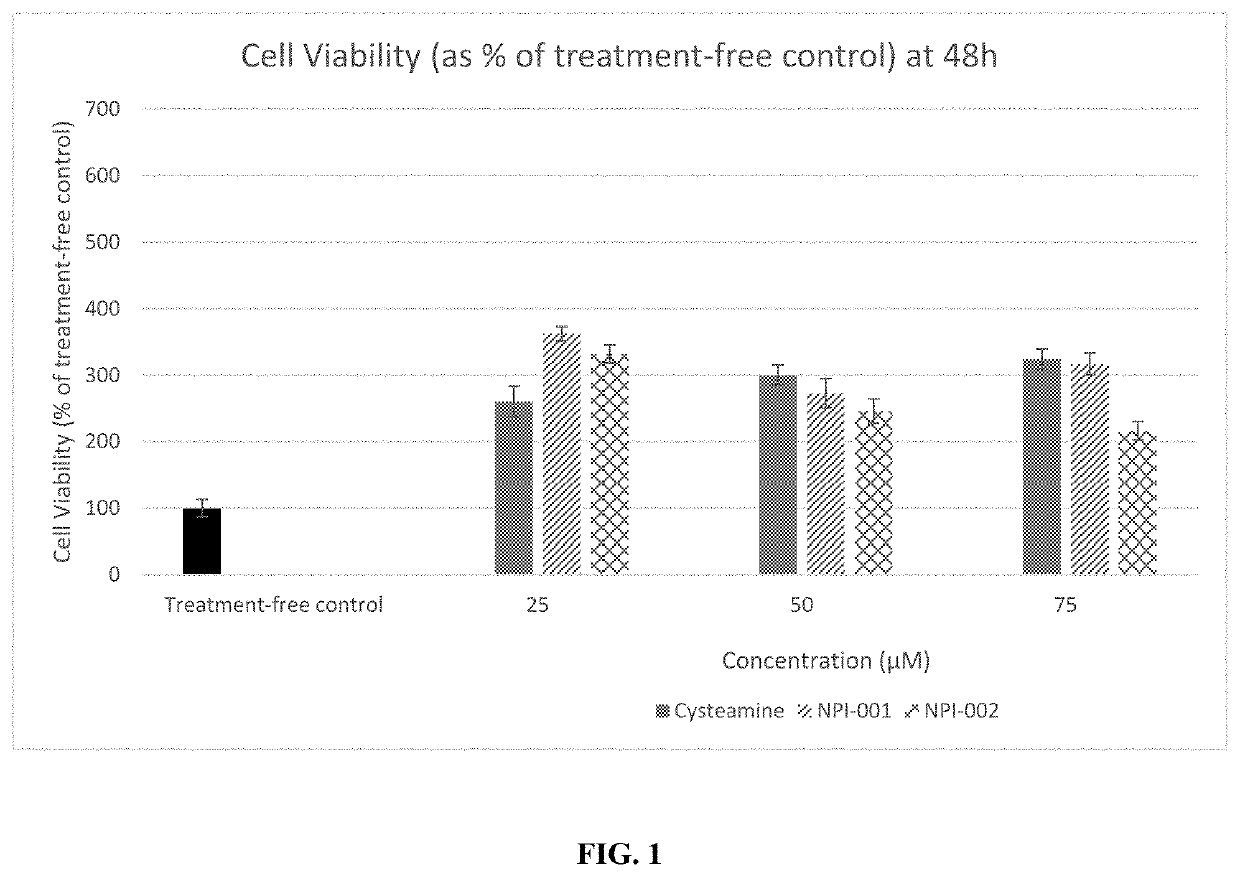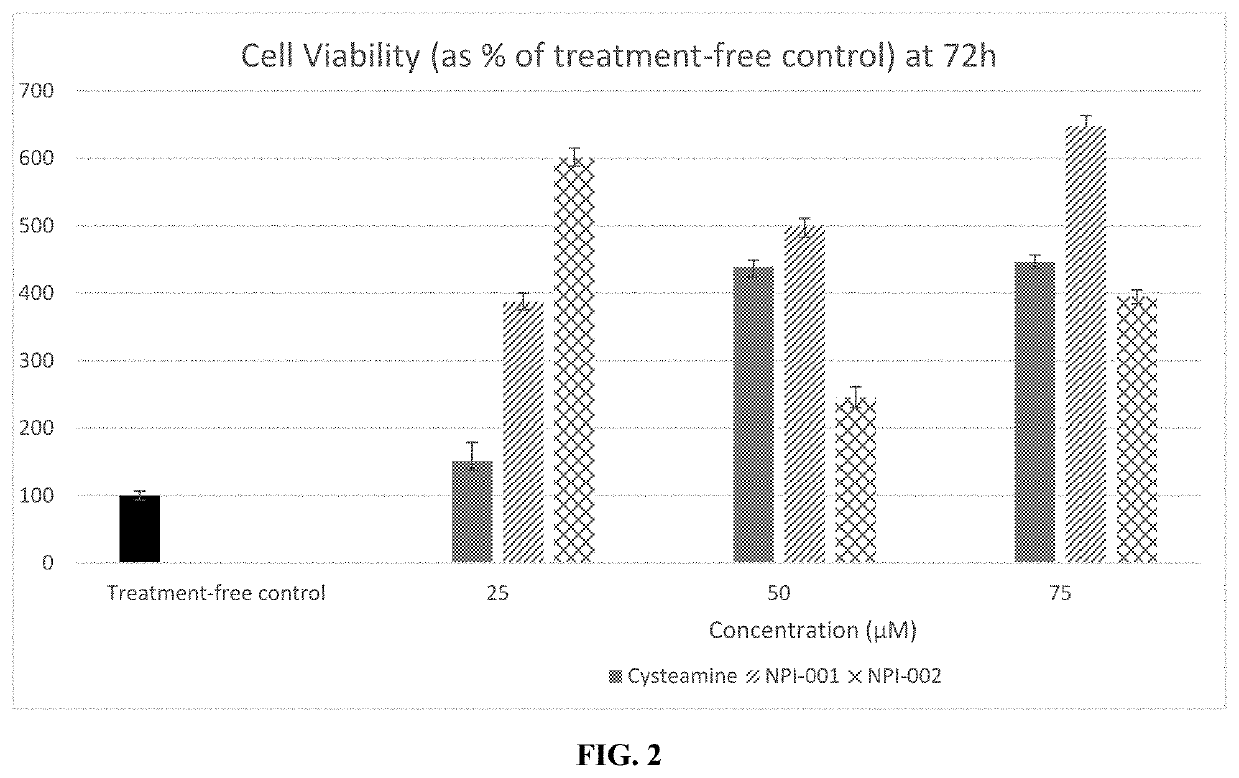Treatment of cystinosis
a cystinosis and cystinosis technology, applied in the field of cystinosis treatment, can solve the problems of low systemic, low membrane penetration, and limitations of nac use, and achieve the effect of modulating the delivery of nac and prolonging the duration
- Summary
- Abstract
- Description
- Claims
- Application Information
AI Technical Summary
Benefits of technology
Problems solved by technology
Method used
Image
Examples
example 1
Cytotoxicity of NACA and diNACA in Cystinotic Fibroblast Cell Culture
[0116]Appropriate concentrations of the NACA and diNACA were selected and incubated along with human cystinotic fibroblasts in media. Cystinotic fibroblasts (GM00008, Coriell Cell Repositories, NJ, USA) were cultured in 96 well plates incubated for 0-72 h in the presence of 25, 50 or 75 μM each of either cysteamine, NACA or diNACA. Media was then removed, and cells were incubated in 0.5mg / ml MTT (3-(4,5-dimethylthiazol-2-yl)-2,5-diphenyltetrazolium bromide) reconstituted in media. A colorimetric assay used reduction of the yellow tetrazolium salt (MTT) to a purple formazan salt in order to measure cellular metabolic activity as a proxy for cell viability. Treated cells were incubated in MTT for 4 hours at 37° C., after which time intracellular purple formazan salt crystals were visible under a microscope. MTT solution was then removed, and DMSO was added to each well in order to lyse cells and dissolve the salt cry...
example 2
Screening of Cystine-Depleting Activity of NACA and diNACA
[0117]A specialized in vitro human cystinotic cell-based model was used for determining cystine content (Omran et al., 2011c). Cystinotic fibroblasts (GM00008, Coriell Cell Repositories, NJ, USA) were seeded in a 25cm3 vented flask and allowed to reach approximately 80% confluence before the addition of the test articles; 50 μM of either cysteamine, NACA (NPI-001) and diNACA (NPI-002) in 4 cm3 Eagle's minimum essential media supplemented with 15% FBS, 200 U / ml penicillin, 200 μg / ml streptomycin and 2 mM glutamine. This was incubated at 37 ° C. and 5% CO2 for 24 h. The cells were harvested, frozen in liquid nitrogen and stored at −80° C. until the cysteine concentration was determined per quantity of protein.
[0118]The cells were recovered from storage at −80° C. and suspended in 100 μl mM N-ethyl malimide prepared in phosphate buffer (pH 7.6) followed by sonication for 10 seconds which was repeated 3 times with 20 second cooli...
example 3
Ophthalmic Tolerability of 1% NPI-001, 1% diNACA, 1% NAC or vehicle
[0124]To simulate topical ocular exposure to an ophthalmic insert containing AGENT, prototype ophthalmic formulations were prepared containing either 1% NPI-001, 1% diNACA, 1% NAC or vehicle and tested to evaluate ocular tolerability. Three rabbits per group were administered 1% NPI-001, 1% di-NAC, 1% NAC in a prototype vehicle, via bilateral topical administration four times a day for 6 days, and once on Day 7. Mild discharge was observed at low frequencies in all four administration groups, and mild hyperemia was observed at low frequencies in the 1% NAC and vehicle administration groups. No indications of chemosis were seen in any of the administration groups. Because the vehicle treatment showed similar or greater frequency of mild ocular irritation indicated by discharge or hyperemia, the ocular irritation seen in the test agent administration groups are likely not attributable to the test agent themselves, but ...
PUM
| Property | Measurement | Unit |
|---|---|---|
| temperature | aaaaa | aaaaa |
| pH | aaaaa | aaaaa |
| molecular weight | aaaaa | aaaaa |
Abstract
Description
Claims
Application Information
 Login to View More
Login to View More - R&D
- Intellectual Property
- Life Sciences
- Materials
- Tech Scout
- Unparalleled Data Quality
- Higher Quality Content
- 60% Fewer Hallucinations
Browse by: Latest US Patents, China's latest patents, Technical Efficacy Thesaurus, Application Domain, Technology Topic, Popular Technical Reports.
© 2025 PatSnap. All rights reserved.Legal|Privacy policy|Modern Slavery Act Transparency Statement|Sitemap|About US| Contact US: help@patsnap.com



